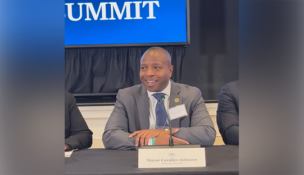Program reaches out to minority teens
By: dmc-admin//December 10, 2003//
 |
|
Hon. Maxine A. White |
Fifty-nine percent of the state’s African-American population does not finish high school. That’s according to a study of graduation rates by the Manhattan Institute.
It’s a dismal statistic, and one that Milwaukee County Circuit Court Judge Maxine A. White wants to change.
White is chairing an outreach project for the National Association of Women Judges (NAWJ) called “The Color of Justice.” Its goals are, first and foremost, to encourage minority students to complete their high school diplomas, and secondly, to consider careers in law. A central topic that White will incorporate into the project are ideals from Brown v. Board of Education, since 2004 will mark that decision’s 50th anniversary.
A pilot program of sorts was conducted at the Milwaukee County Courthouse on Thursday. Twenty-five Milwaukee-area teens — some who are enrolled in school but are not straight-A students, and some who have already dropped out — met with faculty in small groups, listened to panel discussions on career preparation, as well as the panelists’ personal and professional insights, and then interacted with them. The teens were chosen by the Private Industry Council of Milwaukee, as part of its REACH, STEP-UP and Jobs for Wisconsin Graduates programs. Private Industry Council representatives transported them to the courthouse and are in the process of evaluating the program’s success with White, now that it’s been given an initial test.
Regarding the faculty at the December program, White, who serves as the district director for NAWJ’s District 9, says she sent e-mails to just about every lawyer, judge and law enforcement official in her address book, and was highly gratified — but not surprised — by the huge number who expressed a desire to help. Members of the state and federal benches took time out to meet with the teens.
“But that’s our track record in Milwaukee. We want to help,” she observes.
As for follow-up, White says that she and Private Industry Council representatives will give great weight to what the teens said about the program — if the discussions moved them, if they wanted more or less time to interact with the presenters, and what kind of follow-up, if any, they desired. The Private Industry Council bears the primary responsibility for that, White says, but she’s open to options such as job-shadowing, for example.
They’ll also use the teens’ feedback to plan a series of programs throughout 2004, at as many Milwaukee public middle or high schools as possible, where perhaps even hundreds of teens will meet with representatives of the legal community. If just one of the attendees decides, as a result, to stay in school and possibly choose a career in law, then the program will be deemed a success, White says — although she hopes that number is much higher.
| |
||
|
Links |
||
| |
||
One of the best aspects of last week’s program, she notes, is that its cost was minimal. With the Private Industry Council covering transportation and the NAWJ covering lunch, the only other significant component was the presenters’ time — and as previously stated, she had no trouble finding people who cared enough to give a few hours.
The program will then be duplicated in other parts of the county and state, through other members of the NAWJ, the judiciary and bar associations, using Milwaukee’s experiences as a blue print.
The “Color of Justice” program is a complement to White’s participation in a similar program, “Connecting Court-rooms to Classrooms.” The latter program, spearheaded in part by her colleague, Judge Carl Ashley, pairs eighth-grade students from Milwaukee’s public schools with members of the judiciary for one-on-one interaction, some of which is by e-mail and some is face-to-face. These students, however, are chosen in part by their achievement and are not “at-risk” — a label
with which White is not comfortable, she states. White, along with Judge Jeffrey Wagner, works with students at the Milwaukee Education Center.
For more information about the “Color of Justice” program, contact White at [email protected] or (414) 278-4482.
Legal News
- Giuliani, Meadows among 18 indicted in Arizona fake electors case
- Some State Bar diversity participants walk away from program
- Wisconsin court issues arrest warrant ‘in error’ for Minocqua Brewing owner
- Iranian nationals charged cyber campaign targeting U.S. Companies
- Facing mostly white juries, are Milwaukee County defendants of color truly judged by their peers?
- Milwaukee Mayor speaks in D.C. Tuesday at White House water summit
- Chicago man sentenced to prison after being caught with ‘Trump Gun’
- FTC bans non-competes
- Gov. Evers seeks applicants for Dane County Circuit Court
- Milwaukee man charged in dismemberment death pleads not guilty
- Democratic-led states lead ban on the book ban
- UW Madison Professor: America’s child care crisis is holding back moms without college degrees
WLJ People
- Power 30 Personal Injury Attorneys – Russell Nicolet
- Power 30 Personal Injury Attorneys – Benjamin Nicolet
- Power 30 Personal Injury Attorneys – Dustin T. Woehl
- Power 30 Personal Injury Attorneys – Katherine Metzger
- Power 30 Personal Injury Attorneys – Joseph Ryan
- Power 30 Personal Injury Attorneys – James M. Ryan
- Power 30 Personal Injury Attorneys – Dana Wachs
- Power 30 Personal Injury Attorneys – Mark L. Thomsen
- Power 30 Personal Injury Attorneys – Matthew Lein
- Power 30 Personal Injury Attorneys – Jeffrey A. Pitman
- Power 30 Personal Injury Attorneys – William Pemberton
- Power 30 Personal Injury Attorneys – Howard S. Sicula











